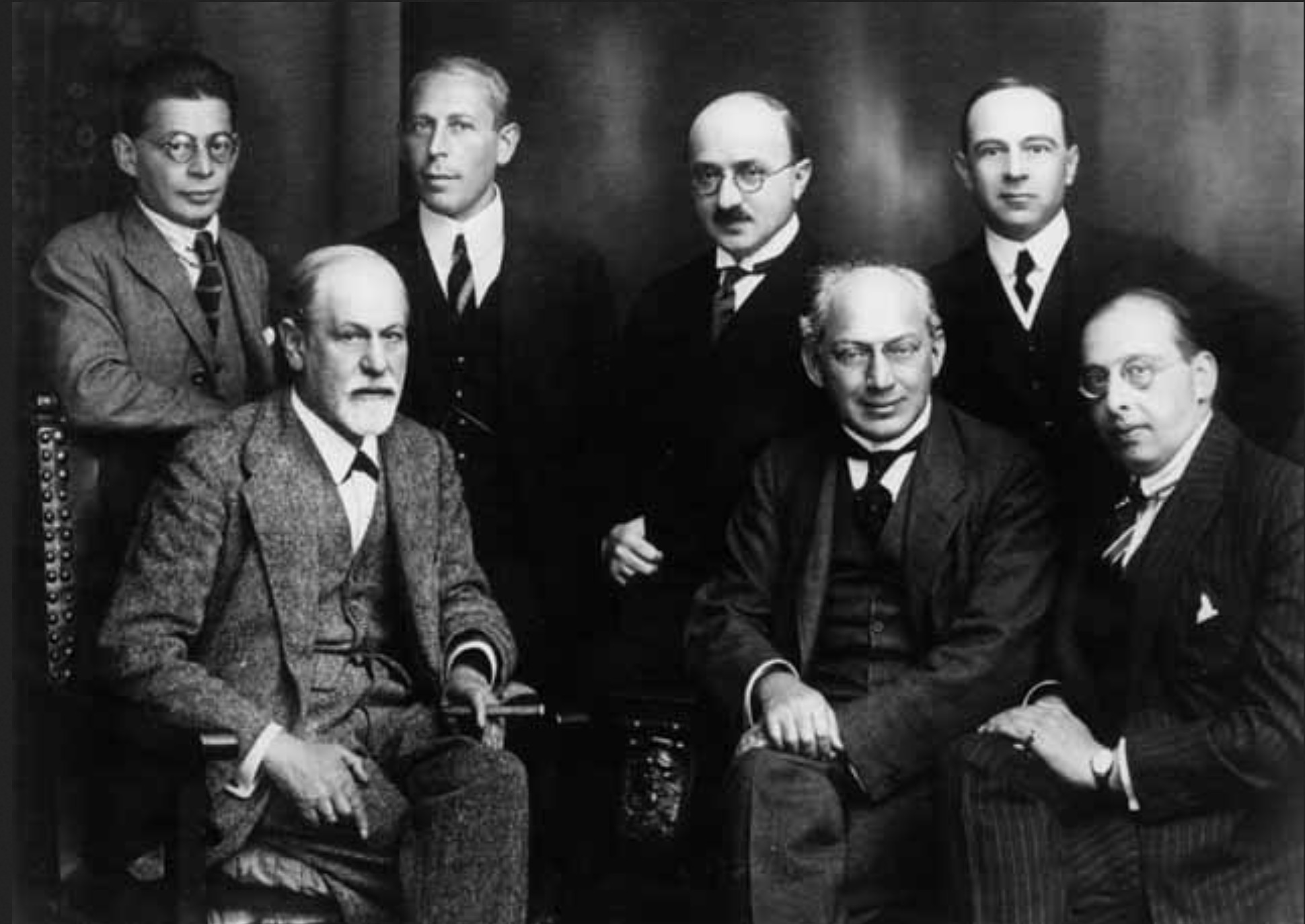
Otto Rank, cropped from the larger
group photograph shown below.
Source: Library of Congress Prints
and Images via Wikimedia
Commons (public domain).
Otto Rank (1884-1939) was the first lay analyst, or non medically-qualified member, of the pioneering Vienna Psychoanalytic (Psa.) Society. Alfred Adler (1870-1937) introduced him to the group in 1906, and he likely attended one or more meetings of the nascent Wednesday Psychological Society, (Jones 1955, "Emergence from Isolation"). Rank appears to have been from an under-privileged background, and to have received much encouragement from Freud to complete his education. Rank attended the University of Vienna where, in 1911, he presented a pioneering psycho-literary study of the Lohengrin Saga, an opera with medieval themes by Richard Wagner (1813-1883). Previously Freud had also steered Rank to the successful publication of a book, Der K¨nstler (The Artist), in 1906-07.
Freud held Rank in such high esteem that he appointed him to ta number of important positions in the early days of psychoanalysis. In 1908, Rank became Secretary to the Vienna Psa. Society, a paid position; in 1912, co-editor of the new Internationale Zeitschrift für Ärtzliche Psychoanalyse (International Journal for Medical Psychoanalysis); and, in 1911, co-editor of Imago, a journal of applied psychoanalytic studies whose name, chosen by Hanns Sachs (1881-1947), evoked the title of the profound novel by Carl Spitteler (1845-1924), a Swiss poet. From 1914 to 1930, Rank updated the very large bibliographies in various new editions of Freud's major work The Interpretation of Dreams while also contributing two new chapters on applied psychoanalysis (Rank 1914).

The "Committee" in 1922 (from left to right): Otto Rank, Sigmund Freud, and Karl Abraham, with Max Eitingon, Sándor Ferenczi, Ernest Jones, and Hanns Sachs. Source: as above.
At the Third International Psa. Congress, held at Weimar in 1911, Rank presented a paper on "The Motif of Nudity in Poetry and Legends." A year later, as part of the reaction of Freud's closest supporters to the difficulties presented by Carl Gustav Jung (1875-1961) and others in the Zürich group, Rank became the youngest member of the famously protective inner "Committee." His wartime experiences proved disastrous: Conscripted in June, 1915, by which time all hopes of early victory had been dashed, he was soon transferred to distant Krakow; following a winter of depression, he suffered a second, more severe attack in late 1917. These developments have been cited to account for his postwar personality, which was perceived to have changed, anticipating his break with Freud's circle (Jones 1957). On the other hand, Freud may have alienated Rank with his contemptuous attitude toward his new spouse, Beata Minzer Rank (1886-1961), whom Freud called "the little Polish Hausfrau."
By 1924 Rank was ready to strike out on his own with respect to both technical matters (Ferenczi & Rank 1924) and theoretical questions (Rank 1924). While Freud tolerated the technical innovations of "active therapy" as individualistic variations amongst analysts, theoretical divergence was anathema, particularly if it involved a fundamental overthrow of a principal Freudian shibboleth, namely the centrality of the Oedipus complex in child development. Rank's presentation of apparent evidence for a "birth-trauma," which he posited as occurring some years earlier than Freud's formative early Oedipal events, and his new and caustic emphasis on the terminological "pre-oedipal" primacy, prepared the way for a repetition of earlier disputes with Carl Gustav Jung (1875-1961), Alfred Adler (1870-1937), and Wilhelm Stekel (1868-1940).
Between 1926 and 1939, the Ranks lived in Paris; Beata Rank would eventually emigrate to New York City. During this period, Rank frequently visited to United States where he disseminated new insights related to depth psychology at universities such as Harvard, Stanford and Yale. Rank died in New York City in 1939.
Related Material
Bibliography
Jones, Ernest.The Life and Work of Sigmund Freud. Vols. II and III. London: Hogarth Press, 1955, 1957.
Liebermann, E. James and Kramer, R. The Letters of Sigmund Freud and Otto Rank. Inside Psychoanalysis. Baltimore: Johns Hopkins Press, 2012.
Rank, Otto.Der Künstler. Ansätze zu einer Sexualpsychologie (The Artist. Approaches to a Sexual Psychology). Leipzig, Vienna, and Zürich: Internationaler Psa. Verlag, 1907.
_____. Der Mythus von der Geburt des Helden: Versuch einer Mythendeutung. (The Myth of the Birth of the Hero: An Attempt at Myth Interpretation). Vienna and Leipzig: Franz Deuticke Verlag, 1909.
_____. "Traum und Dichtung. (Dream and Poetry)." In Sigmund Freud, Die Traumdeutung (The Interpretation of Dreams). 4th edn. Leipzig & Vienna: Deuticke, 1914.
_____. "Traum und Mythus (Dream and Myth." In Sigmund Freud, Die Traumdeutung (The Interpretation of Dreams). 4th edn. Leipzig & Vienna: Deuticke, 1914.
_____. Das Trauma der Geburt und seiner Bedeutung für die Psychoanalyse. (The Trauma of Birth and Its Importance for Psychoanalysis). Leipzig, Vienna, and Zürich: Internationaler Psa. Verlag, 1924.
_____. The Trauma of Birth. New York. Robert Brunner. [1924] 1952. Subsequent English editions of this most important work by Rank include New York: Harper Collins, 1973 et seq.
_____, and Ferenczi, S. Entwicklungsziele der Psychoanalyse (The Development of Psychoanalysis). Nervous & Mental Diseases Publishing Co., 1925. Originally published in 1924.
_____. Art and Artist. New York: Tudor Publishing Co., 1932.
Created 01 March 2021